The construction of the wonderful canon of logarithms
The construction of the wonderful canon of logarithms
The construction of the wonderful canon of logarithms
You also want an ePaper? Increase the reach of your titles
YUMPU automatically turns print PDFs into web optimized ePapers that Google loves.
—<br />
;<br />
Appendix, 163<br />
man ma<strong>the</strong>maticians, as he mentions in his Preface, not being satisfied<br />
with Napier's demonstration based on Arithmetical and Geometrical<br />
motion. <strong>The</strong> two parts toge<strong>the</strong>r with <strong>the</strong> Table are reprinted in<br />
'Scriptores Logarithmici,' vol. I. p. i. At <strong>the</strong> beginning <strong>of</strong> <strong>the</strong> same<br />
volume is reprinted <strong>the</strong> Introduction to Hutton's Ma<strong>the</strong>matical Tables,<br />
on p. Hii <strong>of</strong> which will be found a "brief translation <strong>of</strong> both parts,<br />
omitting only <strong>the</strong> demonstrations <strong>of</strong> <strong>the</strong> propositions, and some ra<strong>the</strong>r<br />
long illustrations <strong>of</strong> <strong>the</strong>m."<br />
<strong>The</strong> <strong>logarithms</strong> in <strong>the</strong> Table are <strong>of</strong> <strong>the</strong> same kind as Napier's, but<br />
<strong>the</strong>y are not affected by <strong>the</strong> mistake in <strong>the</strong> computation <strong>of</strong> <strong>the</strong> Canon<br />
<strong>of</strong> 1614.<br />
<strong>The</strong> Tables <strong>of</strong> Kepler and Napier are differently arranged, and <strong>the</strong><br />
numbers for which <strong>the</strong> <strong>logarithms</strong> are given are also different. In<br />
Napier's Canon <strong>the</strong> numbers in column "Sinus" are <strong>the</strong> values <strong>of</strong><br />
sines <strong>of</strong> equidifFerent arcs, while in this table <strong>the</strong> numbers or sines are<br />
equidififerent. For specimen page <strong>of</strong> <strong>the</strong> Table see preceding page.<br />
<strong>The</strong> arrangement is as follows :<br />
Column 2 contains looo equidififerent numbers, 10,000, 20,000,<br />
30,000, . . . 9,980,000, 9,990,000, 10,000,000. It also has at <strong>the</strong> beginning<br />
<strong>the</strong> 36 numbers i, 2, 3, to 9; 10, 20, 30 to 90; 100, 200 to<br />
900 ; and 1000, 2000 to 9000.<br />
Column 4 contains <strong>the</strong> <strong>logarithms</strong> <strong>of</strong> <strong>the</strong> numbers in column 2, with<br />
interscript differences.<br />
<strong>The</strong> 2nd and 4th are <strong>the</strong> only columns containing entries for <strong>the</strong> first<br />
36 numbers.<br />
It will be observed that a point marks <strong>of</strong>lf <strong>the</strong> last two figures <strong>of</strong> <strong>the</strong><br />
values in <strong>the</strong>se two columns, but if it be left out <strong>of</strong> account <strong>the</strong> numbers<br />
and <strong>logarithms</strong> agree with those <strong>of</strong> <strong>the</strong> Canon <strong>of</strong> 16 14, in being referred<br />
to a radius <strong>of</strong> 10,000,000. So that <strong>the</strong> values really represented are<br />
<strong>the</strong> ratios <strong>of</strong> <strong>the</strong> numbers <strong>the</strong>re given to 10,000,000.<br />
Taking as an example <strong>the</strong> first entry in <strong>the</strong> specimen page, <strong>the</strong> number<br />
in column 2 which is 4,850,000 represents <strong>the</strong> ratio 4,850,000 to<br />
part <strong>of</strong> radius. Similarly column<br />
I o, 000, 000 or a j^ggg ^^th = a yM**<br />
I gives <strong>the</strong> arc, in degrees, minutes, and seconds, corresponding to a<br />
sine equal to <strong>the</strong> j-^th part <strong>of</strong> <strong>the</strong> radius, with interscript differences<br />
Column 3 gives in hours, minutes, and seconds <strong>the</strong><br />
day <strong>of</strong> 24 hours ; and finally<br />
xMf^h part <strong>of</strong> a<br />
X 2 Column


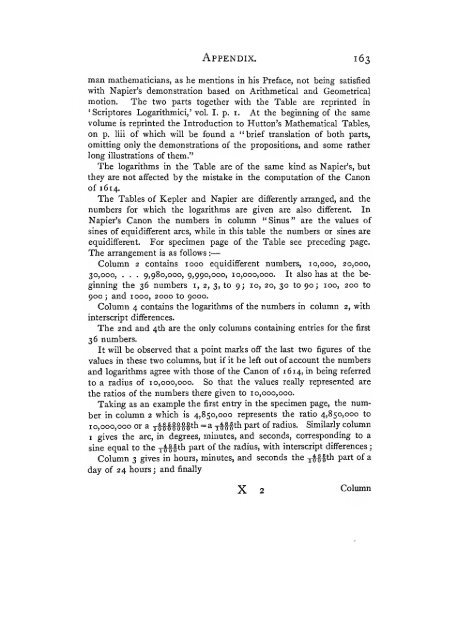
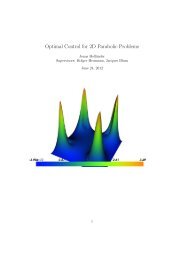

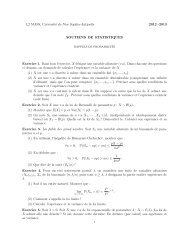
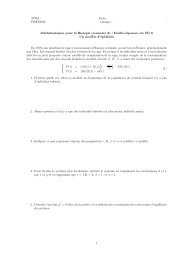


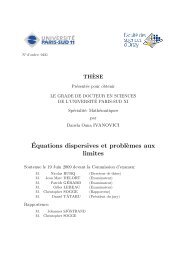
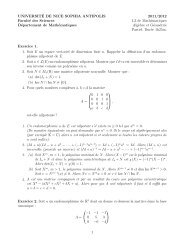
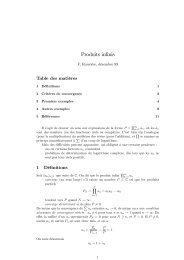
!['eries enti\`eres (+ [D78 Th d'Abel angulaire])](https://img.yumpu.com/14067031/1/184x260/eries-entieres-d78-th-dabel-angulaire.jpg?quality=85)

